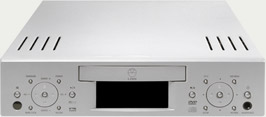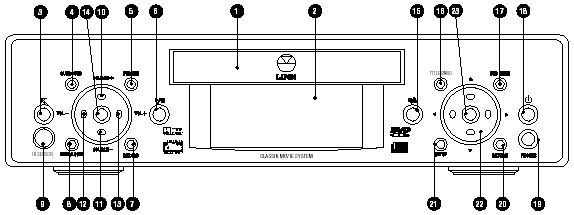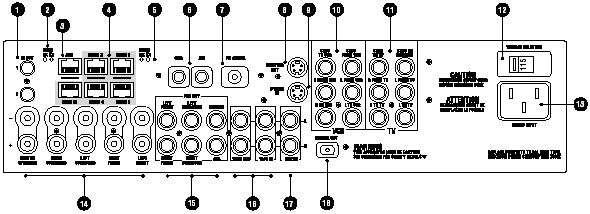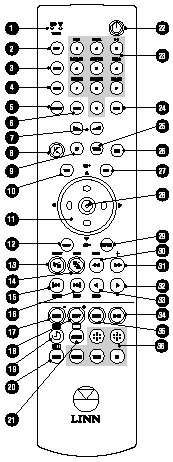
There seems to be a definite market for "lifestyle" systems, probably due to factors such as an increasing trend towards people living in smaller homes and cosy apartments (with no space for bulky "audiophile" sized equipment) and a genuine desire for electronics that look "good" and blend in more with the overall interior design. Typical audio and home theatre gear seem downright ugly - who wants to live in a house that looks like the cockpit of a Boeing 747 or the mixing desk of a recording studio? (OK, OK, maybe some of us do!)
The Danish manufacturer Bang & Olufsen was the first manufacturer to emphasize the exterior design of their equipment, but it was speaker manufacturer Bose that pioneered the "lifestyle" concept - all-in-one entertainment systems that are small and pretty - making a statement about decor and design as well as an audio/visual one. Pretty soon Bose were joined by other manufacturers, notably Nakamichi, and now virtually every major Japanese electronics manufacturer has jumped into the act with mixed results.
Still, I was surprised to discover than Scottish manufacturer Linn has now also entered into the arena with the Classik range. Surprised, because the whole concept of "lifestyle" systems (with the implicit but never acknowledged understanding that these systems sacrifice quality for design style) seems alien to the philosophy of specialist "audiophile" manufacturers. Indeed, some manufacturers seem to revel in the fact that their equipment sounds good but looks ugly - as if daring their customers (almost invariably male) to test the "wife acceptance factor."
And in the totem pole of exclusive and revered audio manufacturers, Linn is right up there. For many years, the Linn Sondek LP12 turntable was the record player to buy, and even now (an updated version of the LP12 is still manufactured today) some will say it is the best turntable money can buy. Since then, Linn has expanded into offering the full range of audio equipment including CD players, amplifiers, speakers and even cables and recordings.
Still, I did not expect Linn to release a lifestyle system, but then I did not expect Linn to ever release a CD player (given founder Ivor Tiefenbrun's vitriolic anti-CD bashing when the format was initially launched) which just goes to show how wrong I can be. Linn's rationale, as explained on the www.classik.com web site, is that most lifestyle systems today (meaning those produced by their competitors) "disappoint" when performing their primary function - reproducing sound. Linn wanted to offer a "no compromise" lifestyle system - something that sounds as good as "audiophile-quality" separate components, but at a fraction of the size (though sadly not a fraction of the price) and which looks good as well.
There are currently two systems in the range; a "Music System" consisting of an integrated CD player, AM/FM tuner and a stereo integrated amplifier; and a "Movie System" (under review here) that has all that, plus it plays DVDs (with integrated Dolby Pro Logic, Dolby Digital and dts decoding) and has a 5 channel amplifier (the LFE channel needs to be externally amplified, typically by a powered subwoofer). There is also a matching loudspeaker package consisting of "Unik" bookshelf speakers and the "Afekt" subwoofer.
By now, you have probably realised that Linn has a strange "affection" for naming all their products with the letter "k" somewhere in the name, thus risking potential confusion with Ikea who also share the disturbing tendency to k-ize their products. Then again, you might like it, particularly if you live in a trendy apartment in King's Kross (sorry!) filled with Ikea and Linn and you drive a Mercedes-Benz Kompressor!
Because this unit has many functions in addition to being a DVD player, I tested the unit in various configurations corresponding to typical installations:
I also tested the tuner capabilities of the unit briefly and it is adequate with reasonable sound quality. Tuner presets can be named alphabetically, but there are no advanced features such as RDS (no big loss, as RDS take up in Australia is pretty patchy). I did not test the unit's multi-room connectivity and operation.
Linn advertises the Classik as a "5.1 75 watt/channel" system, but I think that's stretching the truth a little bit. Yes, the unit will deliver 75 watts per channel - as long as you are only driving 1 channel at the time and the speaker impedance is 4 ohms. The actual technical specifications read:
"Power output 75W into 4 ohm load per channel
40W into 8 ohm load per channel
Maximum power output 75W distributed to all channels"
In other words, it's probably equivalent to a 20 watt stereo amplifier when driving two channels at once. Still, this is not too shabby for a unit of its size. I would recommend using high efficiency speakers, and not listening to DVDs at reference level! Given that the target market for lifestyle systems will probably use the unit most of the time at relatively low volume levels ("background listening") the unit should perform just fine.
One thing that annoyed me is that the unit is fan cooled, and the fan will definitely come on after about 15 minutes to half an hour of listening. The fan is rather loud and annoying, so I recommend putting this unit behind a glass door to shield the noise.
Linn advertises the Unik as a "full range" speaker and that's also somewhat stretching the truth. Unless of course you consider a frequency response of 80Hz to 20KHz ± 3dB as "full range." I suspect Linn is trying to differentiate these speakers from "satellite" speakers which typically have a bass response that disappears below 100-120Hz or so. The frequency response of these speakers is actually quite decent (comparable to typical bookshelf speakers) given that these speakers are quite small, coming somewhere between a satellite and a bookshelf speaker in terms of size.
The Movie System is available in five "designer" colours: Koral Blue, Silver, Arctik White, Black and Baltik Green. I was supplied with a Silver review unit, which matches the silver finish of my Panasonic TV and the DGTEC digital TV set top box.
The review unit appeared to be a production version in retail packaging. The following items were included in the box:
When initially powered up for the very first time, the unit asks you to select a region for the tuner (US, Japan, Europe etc.). This configures the frequency "gap" or "spacing" between adjacent AM radio stations when the tuner is scanning for stations. I selected US at random because I could not find Australia only to discover I should have selected Europe or Japan (as the unit scans in 10kHz steps instead of 9kHz which is the spacing for AM stations in Australia). Unfortunately I could not find any way of getting back to this menu to reconfigure the tuner settings and of course it is not documented in the manual.

As can be seen, the Classik Movie System is a very compact and stylish unit indeed, looking more like an elegant games console than a piece of home theatre equipment, and the silver colour blends in very well with the recent trend towards silver for TVs and VCRs. The extremely small size means it can comfortably fit into spaces where traditional "rack-sized" units cannot. It does, however, require some clearance behind the unit (to allow for cables to be plugged into the rear panel sockets) as well as on top of the unit (which have ventilation holes - the unit is fan-cooled just like a PC).
The front panel is very symmetrical, with two clusters of buttons arranged on either side of the disc tray (1) and fluorescent display (2):

On the left cluster, we have the IR Sensor (9) as well as the following buttons (from left to right):
On the right cluster, we have a headphone socket (19) as well as the following buttons (from left to right):
Wow! This is a lot of buttons on the front panel for a supposedly "lifestyle" unit, but through clever design the panel does not look cluttered at all and the buttons are reasonably intuitive and usable. I really like the front panel arrangement, which allows me to basically operate the unit without using the remote control (just as well, because the remote is pretty confusing to use as I will detail below.)
The fluorescent display is a fully dot matrix screen, which means it is flexible enough to show a variety of information in different font sizes and also allow the use of graphics. Unfortunately, it also means some of the status messages are in a tiny blocky font that is hard to read.
The display does a really cute animation when you turn the unit off - it shrinks the display to a single horizontal line, then shrinks the line to a single dot, whilst progressively dimming the display. In other words, it "emulates" the behaviour of an old style TV. Then you get an icon representing the unit in "sleep" mode.

I received the "US" version of the unit, which has RCA sockets for audio/video connections to the TV and VCR instead of SCART. This suited me just fine, since I don't have any equipment that uses SCART but if your TV and/or VCR does you may want to enquire as to whether you can get the "European" version.
The unit has a reasonable set of input and output connections, with the major omissions being component video output and coaxial digital out. From left to right and top to bottom, we have:
You can probably guess from the multiple RJ-45 connectors that Linn allows you to "network" up to four Classik Movie units in a multi-room installation. One unit will act as a "master" and the other units can act as "slaves" reproducing the same audio/video source as the master, or they can also act in "local" mode whilst connected to a "master."
I quite like the provision of an IEC power socket allowing you to substitute different length (and also higher quality) power cables. I did not like the use of "BFA" speaker connectors, since BFA plugs are uncommon in Australia. The advantage of using BFA connectors is that they reduce the chances of speaker wire shorts which can damage both amplifiers and speakers.
The unit comes with two pairs of BFA plugs which is only enough for connecting to one pair of speakers, which means if you have a 5.1 speaker setup you need to hunt around for an additional three pairs. Fortunately, if you buy the matching Linn Unik/Afekt speakers, these come with speaker cables appropriately terminated using BFA plugs on one end and bare wire on the other.
 The remote control is fairly long and thin and contains quite a lot of buttons:
The remote control is fairly long and thin and contains quite a lot of buttons:
I really dislike this remote control for many reasons:
A big, thick spiral-bound A5 sized manual is supplied. However, upon closer inspection the thickness is due to the fact that English, French, German, Spanish, Italian, Dutch and Portuguese versions are supplied. The English portion of the manual is just under 50 pages, which makes this a fairly brief manual for a unit with so many functions.
I don't like the manual very much either. It omits documenting key aspects of the unit's operation, such as its ability to play Super Video CDs and MP3 CD-ROMs. What it does document is sometimes done in a very cryptic and uninformative style. For example, this is what the manual has to say about the "Picture Mode" setup parameter:
"If when viewing a DVD the screen image flickers, choose a different option; either AUTO (suitable for most DVDs), HI-RES (high resolution) or N-FLICKER (non-flicker)."
Helpful, no? After reading that, I still have no idea what this setting is supposed to do. It would seem to imply that the unit upconverts to HDTV or progressive scan (neither of which it does). I suspect this setting applies different parameters to the vertical aliasing filter in the Video DAC.
The on-screen setup menu is accessed by the SETUP key. I would have liked the menus to be displayed on the display panel as well (which should be possible given that it is a dot-matrix display) to allow the flexibility of configuring the unit without a display monitor.
The setup parameters are divided into four categories:
GENERAL SETUP allows you to adjust the following:
SPEAKER SETUP allows you to configure which speakers are connected to the system, whether they are full-range ("Large") or not ("Small"), and their distance from the listener (for time alignment adjustments). There is even a test tone function to allow you to adjust relative channel level (±10) - unfortunately no test tone is provided for the LFE channel which means you can't adjust the level of the subwoofer relative to the other speakers.
AUDIO SETUP allows you to adjust the following:
PREFERENCES allows you to adjust the following:
The preferred language selections in the PREFERENCES menu are by language name, but only for a few selected languages. If your desired language is not one of them, you have to enter a numerical code. The list of available codes is not provided in the manual, but downloadable from www.classik.com.
My major gripe with this player is the lack of support for RGB and/or component video output. The highest quality signal you can get out of this player is S-Video. Apart from that, the player has decent video output quality, however, I noticed a tendency for low level noise (which looks like a textured pattern on the screen) when I connected it to the projector via both S-Video and composite video. I suspect the player's video output signal is not strong enough given I have very long cable runs to my projector. In any case, I did not observe the "patterning" on a 61 cm Panasonic TV.
I calibrated the player by adjusting the display settings of my Sony VPL-VW11HT LCD projector using the Video Essentials test disc (NTSC). It was clear from viewing the Snell & Willcox Test Chart (Video Essentials Title 15 Chapter 12) that the DVD player is capable of extracting maximum horizontal and vertical resolution from the DVD format. I did not notice any video artefacts or abnormality viewing this test pattern (apart from the usual moire effects and slight coloration in the moving zone plate).
The Black level on NTSC discs is set at the NTSC 7.5 IRE level but I suspect the Black level for PAL is set to 0 IRE as I've noticed PAL discs tend to look somewhat darker than NTSC discs after calibration. This will be an issue for you if you have a mixture of PAL and NTSC discs and your display only allows one calibration setting.
The review unit did not seem to have any region zone markings. It seemed to handle a number of Region 1, 2 and 4 discs, so it appears to be a multi-zone capable player.
The unit passed the usual set of "torture" discs that I fed into it, with one minor exception - it has a minor variant of the "chroma upsampling error." This is evident in very slight streaking on the outer edges of red objects (particularly the chequerboard and the red tin lid in Toy Story R1 Chapters 3 and 4). However, unlike some other players I have reviewed, the chroma bug is hardly noticeable on this unit. Unless you are extremely picky, I don't think you will be find it annoying.
I did notice some instances of macro-blocking in various places that I don't recall noticing on my reference player (a Pioneer DV-626D).
The Fast forward/reverse buttons on the remote control will scan at 4X normal speed, but if you press the Scan forward/reverse buttons, you can cycle through multiple speeds including 2X, 4X, 6X and 8X. Similarly, if you press the pause button, the scan buttons then allow to cycle through slow scan speeds including 1/2, 1/4, 1/8 and 1/16. There doesn't appear to be frame advance functionality.
The layer change speed on this player is impressively fast, typically near-instantaneous with only a very minor interruption in the playback even on known problematic discs.
The Format button on the front panel as well as the Setup menu will allow the player to do NTSC to PAL and PAL to NTSC format conversions. I was impressed by this since not many players implement this feature. The player does format conversions reasonably well - I did not detect any obvious and recurring signs of framing or scaling errors.
The player can be set to convert from Dolby Digital/dts/MPEG to PCM on the digital out connections.
I evaluated the unit playing CDs in various configurations:
I also evaluated the player's Dolby Digital and dts decoder as well as digital output playing DVDs on a variety of configurations. The built in decoders are quite good and comparable to high end AV processors, and certainly far superior to those inbuilt to some DVD players I have encountered.
The unit performed reasonably well as a standalone home entertainment system complete with Unik/Afekt speakers in a 5.1 speaker configuration. The built-in amplifiers are probably under-powered for reference level listening, and the speakers are a little too boomy and dull for my taste but more than adequate for low level listening and do bring a reasonable degree of excitement to action movies.
I also tested the player subjectively for audio synchronization by playing the usual problem discs such as The Wedding Singer R4 (remaster #2) and Matrix R1. This player is one of the better players I have encountered in terms of audio synchronization and I did not notice any issues on both discs.
By the way, the unit has a number of surround modes (including Stereo+Sub, Phantom, 3 Stereo, As Mix) but these are only applicable for DVDs and CDs. Also, Dolby Pro Logic decoding is only available for DVDs and CDs, and in particular you cannot apply Dolby Pro Logic to TV and VCR audio sources which is a pity as occasionally TV programs and video tapes are surround encoded. From this I deduce that the unit does not digitise audio inputs from external sources. Whilst this reflects a "purist" attitude that would be consistent with Linn's philosophy, it does reduce the usefulness of the unit to the lifestyle target market.
Here is another pleasant surprise not mentioned in the manual. The Classik will in fact play MP3 CD-Rs, and the implementation is quite good, complete with an "Explorer"-like on-screen display of folders and tracks. The navigation keys can be used to navigate in and out of folders and to select MP3 files to play. The player even reads multi-session discs correctly on both CD-R and CD-RW. The player will support constant bit rate MP3 files with a transfer rate as low as 40 Kb/s. Although the player recognised variable bit rate MP3 files, it does not play them properly (apart from 1 example recorded with 1% quality) and the player will "hang" trying to load them. Fortunately, the hang can be rectified by turning the player off and on.
| Test Disc Format | Results |
| CD-R >100 MP3s (128 Kb/s) in multiple, nested subdirectories | Found all files |
| CD-R >100 MP3s (128 Kb/s) in root directory | Found all files |
| CD-R with MP3s (CBR ranging from 20-320 Kb/s, VBR ranging from 1%-100% quality), 1 WMA and 1 WAV file |
Successfully played all constant bit rate files between 40-320 Kb/s. |
| Multisession CD-RW (2 sessions each containing MP3 files) | Found all files in both sessions |
| Disc |
|
|
| The Matrix R1 Follow The White Rabbit |
|
|
| The Wedding Singer R4 remaster #2 Audio Sync |
|
|
| Terminator: SE R4 Menu Load |
|
|
| Independence Day R4 Seamless Branching |
|
|
| The Patriot R1 RCE |
|
Not tested |
| Toy Story R1 chroma upsampling error |
Chapter 3 and 4 tests for absence of chroma upsampling error |
| Screen Saver |
|
| Zoom |
|
| Video | Component Output | RGB Output | ||
| Audio | DTS Output | MP3 Playback | ||
| Plays CDRs | ||||
| Conversion | PAL-60 | |||
| Inbuilt Decoder | Dolby Digital, dts | |||
| Performance | |
| Build Quality | |
| In Operation | |
| Compatibility | |
| Value For Money |
| Product Type: | Integrated DVD-Video, Audio CD player, AM/FM tuner and 5.1 channel pre/power amplifier |
| Region: | Multi-region player |
| Signal System: | PAL / NTSC |
| Serial Number Of Unit Tested: | 715314 (Assembled, tested and packed by Steven Bolger) |
| MPEG Decoder: | ? |
| Audio Frequency Response: | N/A |
| Signal to Noise Ratio: | FM @ 93.5MHz (60 dBmV signal) –65dB AM @ 1MHz (50 dBmV signal) –45dB CD/DVD/Amplifier: N/A |
| Dynamic Range: | N/A |
| Total Harmonic Distortion: | <0.03% @ 10W into 4 Ohm load (1 channel driven) <0.03% @ 10W into 8 Ohm load (1 channel driven) |
| Dimensions: | 320 mm (w) x 325 mm (d) x 80 mm (h) |
| Weight: | 5 kg |
| Price: | $5,999 |
| Distributor: | Audio Products Australia 67 O'Riordan Street Alexandria NSW 2015 |
| Telephone: | (02) 9669-3477, 1800 642 922 |
| Facsimile: | (02) 9669-3477, 1800 246 262 |
| Email: | info@audioproducts.com.au |
© Chris Tham
23 October 2002